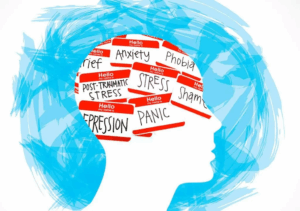 Introduction:
Introduction:
As the world enters the year 2024, understanding and prioritizing mental health is more important than ever. For K–12 students in particular, mental health struggles are overwhelming children and making it difficult for students to consistently go to school and perform well. Disorders such as anxiety, depression, and attention deficit hyperactivity disorder (ADHD) are the most common in children today, according to the National Center for Health Statistics, 2020.[1] The number of students with these disorders is only rising, with 1 out of 5 students between the ages of 3 to 17 experiencing a mental health problem during their school years.[2] There are multiple different factors contributing to these mental health issues, with rising involvement on social media, difficulty at home, increased absence at school, and a lack of proper resources being some of the most prevalent.[3] To start making the necessary adjustments to improve mental health for these students, researchers, administrators, and community members must identify the causes and work towards finding unique solutions that will give individuals the help they need.
Negative Impacts on Mental Health
Social media has been an ongoing threat to student mental health and well-being, but as more become involved online, the risks continue to rise. According to Surgeon General Dr. Vivek Murray, “Social media use by young people is nearly universal, with up to 95% of young people ages 13–17 reporting using a social media platform and more than a third saying they use social media ‘almost constantly.’” This constant exposure is linked directly to increased mental health concerns, with prolonged time on social media causing symptoms of depression and anxiety and increasing the risk of developing an eating disorder, body dysmorphia, and low self-esteem.[4] One of the root causes for this mental health decline from social media is cyberbullying. Cyberbullying or online bullying has been on the rise. According to the CDC, the percentage of children experiencing cyberbullying in K–12 education is: 33% in middle school, 30% in highschool, 20% in combined schools, and 5% in primary school.[9] The combination of online exposure and harassment to still developing young minds causes increased potential for harm, and the gravity of the information they have access to demands better regulation for the sake of student well-being.
Outside of social media, student attendance is declining, which furthers mental health issues as students fall behind and lose access to resources and structure.[3] As students and schools are still adjusting to being back in the classroom post-COVID, the academic environment has been described as overwhelming and less welcoming, making students want to stay home and avoid the environment altogether.[5] According to Stanford University Professor Thomas Dee, 6.5 million students have become chronically absent, with absences being more prevalent among Latino, Black, and lower-income students. Spending time at home rather than at school increases the chances of a student dropping out and means students miss out on school resources such as meals, counseling, and socialization.[5] Poor mental health can be both a cause and effect of lack of attendance, and getting students back into the building is a crucial goal for improving mental health in K–12 education.
In order for students to improve their mental health and academic experience, they must have access to resources for coping with their mental health struggles. Particularly for Hispanic and African American families, students are less likely to be diagnosed and treated due to limited access to care.[6] A scarcity of resources at a school or in the classroom causes educators to “separate students that require greater attention or cause distractions, furthering gaps in knowledge and socialization.”[6] If schools do not have adequate funding for mental health resources, children and adolescents will continue to struggle with their mental health, as they will not have a proper understanding of their condition or how to treat themselves.
Possible Solutions and Improvements
Regarding social media, an ideal way to decrease the effects of the internet on youth is doing research on those effects and taking action accordingly. Dr. Vivey Murthy encourages “urgent action by policymakers, technology companies, researchers, families, and young people alike to gain a better understanding of the full impact of social media use, maximize the benefits and minimize the harms of social media platforms, and create safer, healthier online environments to protect children.”[4] By better understanding its risks, children and teens can learn how to avoid and limit their online presence to avoid furthering its impact on them. On a stricter level, getting rid of specific platforms or media coverage involving violent and sexual content, bullying, and harassment takes away children’s accidental or purposeful exposure to this media.[4]
To increase attendance and mental health, families and schools must collaborate to get children back into the classroom. Communication with students on the value of education and raising awareness of the positive impacts of being at school are crucial factors. Additionally, communication between parents/guardians and teachers/staff on a child’s individual needs and challenges is crucial to helping students get the resources and support they deserve.[7] As explained by the Massachusetts Department of Elementary and Secondary Education, “By working together, families and schools can identify and address attendance issues promptly, promoting a culture where attendance is viewed as a shared responsibility.”
The biggest key to mental health improvement in schools is an increase in mental health resources, which is why funding is so critical. In 2023, the U.S. Department of Education announced $63 million “in new five-year Full-Service Community Schools (FSCS) grants to support 42 local educational agencies, non-profits, or other public or private organizations and institutions of higher education.”[8] Grants such as this one focused on improving academic growth and well-being, give students a chance to become better students, and healthier ones, too.
Additionally, systems for Social Emotional Learning (SEL) are becoming more popular and necessary to help students “acquire and apply the knowledge, skills, and attitudes to develop healthy identities, manage emotions and achieve personal and collective goals, feel and show empathy for others, establish and maintain supportive relationships, and make responsible and caring decisions.”[10] To help children develop as humans and students, SEL grants are being introduced by systems such as the Massachusetts Department of Elementary and Secondary Education. This particular “state funded competitive grant program” will give schools a chance to “respond to the social-emotional and behavioral health needs of students, families, and educators and to build strong partnerships with community-based mental health agencies and/or providers to create comprehensive mental health systems.”[11] Implementing grants such as these throughout different state and federal education systems will give opportunities for educational and mental health improvement to all those involved. Grants such as these should be prioritized and implemented as much as possible, so that children throughout the United States can have equal opportunity and support. Not only that, but access to mental health screenings (as is included in certain grants) will give students a better understanding of themselves and their condition. The U.S. Preventive Services Task Force now recommends a “widespread” screening for anxiety and depression among K–12 students.[3]
Conclusion
Mental health in K–12 students is concerning and needs consistent, ongoing attention. By addressing students’ needs and conditions and considering the causes, schools, students, and parents can work together to improve the mental health of these individuals. It is a battle that requires attention from different angles, and the resources necessary may vary for each student. However, by focusing specifically on social media, attendance, and resource availability, K–12 schools may take a step in the right direction and find their way towards improving their students’ mental health.
Publishing Solutions Group
Publishing Solutions Group is committed to improving and expanding resources for education so that every student can learn and perform to the best of their ability. By paying attention to the mental health issues students face, educators and administrators can foster resources adequate for every student and provide them with the opportunity to improve their academic performance while prioritizing their mental health.
[1]https://onlinelibrary.wiley.com/doi/full/10.1002/pits.22658
[2]https://www.nasponline.org/resources-and-publications/resources-and-podcasts/mental-and-behavioral-health/additional-resources/comprehensive-school-based-mental-and-behavioral-health-services-and-school-psychologists#:~:text=According%20to%20the%20U.S.%20Department,and%20alcohol%20and%20substance%20abuse
[3]https://www.k12dive.com/spons/6-ways-mental-health-support-in-k-12-schools-is-evolving/701667/
[4]https://www.hhs.gov/about/news/2023/05/23/surgeon-general-issues-new-advisory-about-effects-soci4al-media-use-has-youth-mental-health.html
[5] https://projects.apnews.com/features/2023/missing-students-chronic-absenteeism/index.html
[6]https://www.nea.org/nea-today/all-news-articles/widening-mental-health-treatment-gap-schools#:~:text=54%25%2C%20respectively.-,Without%20access%20to%20services%2C%20students%20with%20anxiety%20are%20at%20higher,on%20limited%20access%20to%20care
[7]https://www.doe.mass.edu/sfs/attendance/#:~:text=Family%20Engagement,and%20provide%20the%20necessary%20encouragement
[8]https://www.ed.gov/news/press-releases/us-department-education-announces-63-million-expand-community-schools-and-increase-social-emotional-mental-health-and-academic-support-students-educators-and-families
[9]https://www.linkedin.com/pulse/alarming-surge-cyberbullying-students-k-12-gaggle-net-inc-/
[10] https://casel.org/fundamentals-of-sel/
[11] https://www.doe.mass.edu/grants/2024/613-311/
Illustration by Saulal Albert on Flickr.




